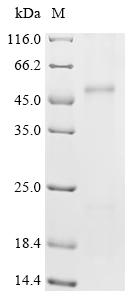Recombinant Mouse Metal cation symporter ZIP14 (Slc39a14)
CAT:
399-CSB-CF748446MO-01
Size:
100 µg
Price:
Ask
- Availability: 24/48H Stock Items & 2 to 6 Weeks non Stock Items.
- Dry Ice Shipment: No




Recombinant Mouse Metal cation symporter ZIP14 (Slc39a14)
- CAS Number: 9000-83-3
- Gene Name: Slc39a14
- UniProt: Q75N73
- Expression Region: 29-489aa
- Organism: Mus musculus
- Target Sequence: SSAGLPPLSATSFLEDLMDRYGKNDSLTLTQLKSLLDHLHVGVGRDNVSQPKEGPRNLSTCFSSGDLFAAHNLSERSQIGASEFQEFCPTILQQLDSQACTSENQKSEENEQTEEGKPSAIEVWGYGFLCVTVISLCSLMGASVVPFMKKTFYKRLLLYFIALAIGTLYSNALFQLIPEAFGFNPQDNYVSKSAVVFGGFYLFFFTEKILKMLLKQKNEHHHGHNHFTSETLPSKKDQEEGVTEKLQNGDLDHMIPQHCNSELDGKAPGTDEKVIVNSMSVQDLQASQSACYWLKGVRYSDIGTLAWMITLSDGLHNFIDGLAIGASFTVSVFQGISTSVAILCEEFPHELGDFVILLNAGMSIQQALFFNFLSACCCYLGLAFGILAGSHFSANWIFALAGGMFLYIALADMFPEMNEVCQEDEKNDSFLVPFVIQNLGLLTGFSIMLVLTMYSGQIQIG
- Tag: N-terminal 10xHis-tagged
- Source: in vitro E.coli expression system
- Field of Research: Metabolism
- Assay Type: CF Transmembrane Protein & Developed Protein
- Relevance: Electroneutral transporter of the plasma membrane mediating the cellular uptake of the divalent metal cations zinc, manganese and iron that are important for tissue homeostasis, metabolism, development and immunity. Functions as an energy-dependent symporter, transporting through the membranes an electroneutral complex composed of a divalent metal cation and two bicarbonate anions. Beside these endogenous cellular substrates, can also import cadmium a non-essential metal which is cytotoxic and carcinogenic. Controls the cellular uptake by the intestinal epithelium of systemic zinc, which is in turn required to maintain tight junctions and the intestinal permeability. Modifies the activity of zinc-dependent phosphodiesterases, thereby indirectly regulating G protein-coupled receptor signaling pathways important for gluconeogenesis and chondrocyte differentiation. Regulates insulin receptor signaling, glucose uptake, glycogen synthesis and gluconeogenesis in hepatocytes through the zinc-dependent intracellular catabolism of insulin. Through zinc cellular uptake also plays a role in the adaptation of cells to endoplasmic reticulum stress. Major manganese transporter of the basolateral membrane of intestinal epithelial cells, it plays a central role in manganese systemic homeostasis through intestinal manganese uptake. Also involved in manganese extracellular uptake by cells of the blood-brain barrier. May also play a role in manganese and zinc homeostasis participating in their elimination from the blood through the hepatobiliary excretion. Also functions in the extracellular uptake of free iron. May also function intracellularly and mediate the transport from endosomes to cytosol of iron endocytosed by transferrin. Plays a role in innate immunity by regulating the expression of cytokines by activated macrophages.
- Purity: Greater than 85% as determined by SDS-PAGE.
- Activity: Not Test
- Length: Full Length of Mature Protein
- Form: Liquid or Lyophilized powder
- Buffer: If the delivery form is liquid, the default storage buffer is Tris/PBS-based buffer, 5%-50% glycerol. If the delivery form is lyophilized powder, the buffer before lyophilization is Tris/PBS-based buffer, 6% Trehalose, pH 8.0.
- Reconstitution: We recommend that this vial be briefly centrifuged prior to opening to bring the contents to the bottom. Please reconstitute protein in deionized sterile water to a concentration of 0.1-1.0 mg/mL.We recommend to add 5-50% of glycerol (final concentration) and aliquot for long-term storage at -20℃/-80℃. Our default final concentration of glycerol is 50%. Customers could use it as reference.
- Molecular Weight: 52.3 kDa
- Storage Conditions: The shelf life is related to many factors, storage state, buffer ingredients, storage temperature and the stability of the protein itself. Generally, the shelf life of liquid form is 6 months at -20℃/-80℃. The shelf life of lyophilized form is 12 months at -20℃/-80℃.
